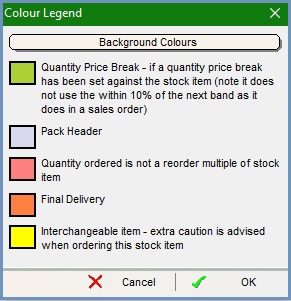Purchase Order List Tab
The [ Purchase Order | List ] screen is accessed either by clicking on the ![]() Purchase Order link on the Command Window or by selecting the Purchase Order radio button at the bottom of the Purchasing List tab.
Purchase Order link on the Command Window or by selecting the Purchase Order radio button at the bottom of the Purchasing List tab.
This screen can be used to create new purchase orders and to search for existing purchase orders. When the screen is first opened the Go button must be pressed to populate the grid.

The Purchase Order list screen consists of three areas:
Notes:
- The filters can be used to display specific purchase orders. When searching using the 'Purchase Order Code' filter, the date range filter is ignored; all other filters work in combination with the date range.
- To open an existing Purchase Order, double-click on it in the grid.
Purchase Order Top Filters
Use the fields in this area to search for specific purchase orders.
- Go: this button must be pressed to populate the grid.
- Purchase Order Code: displays purchase orders with a specific code. This filter has wildcard blocks enabling the user to filter by partial purchase order codes.
- Stock (
 /
/ traffic light filter): displays purchase orders containing a specific stock item. The adjacent
traffic light filter): displays purchase orders containing a specific stock item. The adjacent  button is used to load the stock item.
button is used to load the stock item. - Supplier (
 /
/ traffic light filter): displays purchase orders for a specific supplier. The adjacent
traffic light filter): displays purchase orders for a specific supplier. The adjacent  button is used to load the supplier.
button is used to load the supplier. - Associated Ref: displays purchases orders with a specific associated reference. This filter has wildcard blocks enabling the user to filter by partial associated reference.
- Confirmed tri-state checkbox: if the purchase order has been marked as confirmed then these can be filtered for using this option, for example show:
- All confirmed orders (ticked)
- Unconfirmed orders (unticked)
- Both confirmed and unconfirmed (block) (default)
- Delivered tri-state checkbox:
- Show all delivered orders (ticked)
- Show only undelivered orders (unticked)
- Show both delivered and undelivered orders (block) (default)
- Partly Delivered (default=unticked): when ticked shows all part delivered orders which will have a green background.
- Date (
 /
/ traffic light filter): the date range from the earliest to the latest date to be included in the search. Once set, the dates set will be retained across all the
traffic light filter): the date range from the earliest to the latest date to be included in the search. Once set, the dates set will be retained across all the [ Purchase Order | List ]screens whilst open.
Purchase Order Grid
- Supplier:
- URN: displays the supplier's URN.
- Name: displays the supplier's name.
- Purchase Order:
- Code: the purchase order code.
- Raised: the date the purchase order was raised. This date would usually show when it was created, although it can be changed by the user when raising the purchase order.
- Delivered: the date the purchase order was delivered or part-delivered.
Note: if the purchase order has been part-delivered it will be highlighted in green. - Printed: the date the purchase order was printed.
- Total: the total value of the purchase order including any delivery charges and VAT. The Purchase Order currency is also displayed.
- Volume: the total volume of the stock items on the purchase order.
- Site: the site the purchase order has been raised for.
- User: the user who created the Purchase Order.
Note: this is read-only. - Ass Ref: will display the associated reference as entered on the
[ Purchase Order | Main ]screen.
The following columns can be added into the grid using Grid Configuration. They are hidden by default. Please see Grid Configuration for more details:
- Required: the date the purchase order is required. This date would usually default to the day after the purchase order was created, although it can be manually changed from within the purchase order screen.
- Del Note: this column will show one of the following:
- None: No Delivery Notes are associated with the Purchase Order.
- DN Code: will display the associated Delivery Note code.
- Multiple: multiple Delivery Notes are associated with the Purchase Order.
Totals
The totals boxes at the bottom of the screen displays the total value and volume of all purchase orders currently being displayed within the grid. If purchase orders have been green-selected in the grid, the total is for the selected orders. The colour background of the totals indicates:
- Green: a single currency is being totalled.
- Orange: multiple currencies are being totalled.
Purchase Order Grid Context Menu
- Send To:
- Not logged in: send the focused on purchase order as a Document Notification to a user that is not currently logged in.
- User List (displayed below the Not logged in option: send a Document Notification to a user that is currently logged in.
- Goto Supplier: opens the
[ Supplier | Detail | General ]tab for the currently selected purchase order. - Goto Purchase Order: opens the
[ Purchase Order ]screen for the purchase order focused on in the grid. - Colour Legend: opens the Purchase Order Grid Colour Legend;

- Clear Selection: deselects the currently selected line(s).
